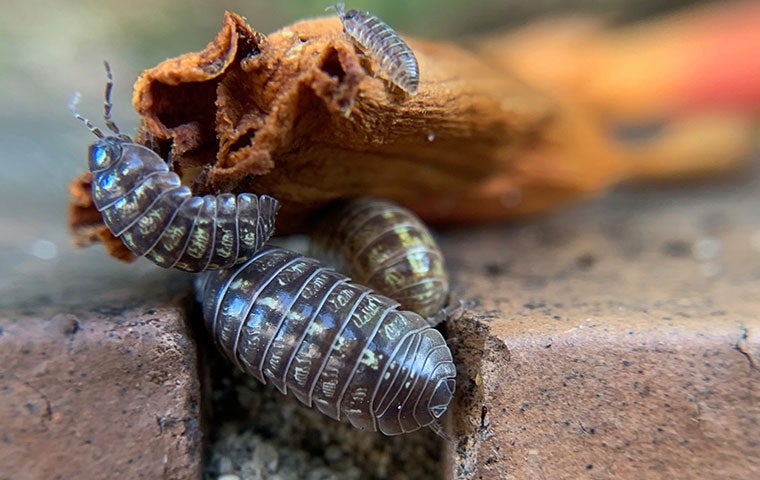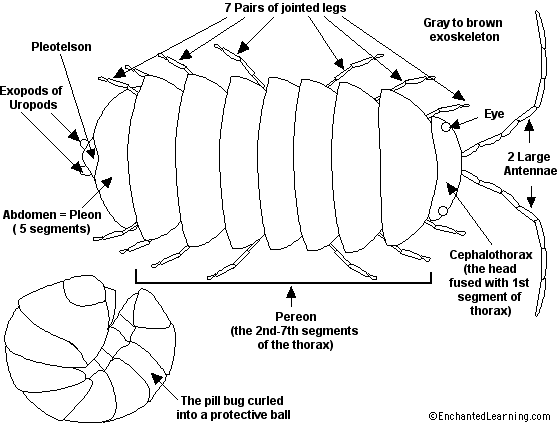Pill bugs, also known as roly polies, use their antennae to constantly monitor their surroundings and identify appropriate living areas.
Pill bugs have specialized sensory structures that allow them to evaluate moisture, temperature, food sources, and the presence of predators or waste.
Read on to learn more about how these familiar isopods detect stimuli, choose ideal habitats, and respond to their environment.
How do Pill Bugs Sense their Environment?

Pill bugs rely heavily on their two pairs of antennae and numerous sensory setae to constantly monitor moisture levels, temperature, pheromones, nitrogen compounds, and other chemical and tactile stimuli that provide feedback on the suitability of their habitat.
This sensory information allows pill bugs to quickly identify problems and relocate if environmental conditions become unfavorable.
Key Points
- Antennae detect moisture, heat, pheromones, nitrogen, and other habitat cues
- Sensory setae give tactile feedback about objects, terrain, and vibrations
- Bright light exposure causes immediate curling into defensive balls
- Ideal conditions are cool, dark, and damp
What Structures Help Pill Bugs Sense Their Habitat?

Pill bugs have two pairs of antennae with receptors that detect scented chemicals, including pheromones and waste, that provide cues about habitat suitability.
They also have sensory setae on their exoskeleton to evaluate moisture, nitrogen, and heat levels.
These structures are essential for pill bugs to identify proper living areas.
Researchers believe the tiny setae allow pill bugs to make detailed tactile maps of their terrain and environment.
These sensitive structures equip them to react to subtle environmental changes.
Pill bugs rely heavily on touch and chemical cues from antennae to gather information.
How Do Pill Bugs Use Their Antennae?
Pill bugs has a unique structure that allows them to survive in their environment.
They use their two pairs of antennae as their main sensory organs to locate suitable habitats and food sources.
Their antennae detect moisture, heat, nitrogen, and chemical signals that help pill bugs identify areas with the right conditions.
If their antennae detect dry, acidic conditions, pill bugs will seek out moist, neutral pH environments instead.
The antennae also allow pill bugs to find each other and potential mates using pheromones.
Overall, antennae provide pill bugs with feedback about the safety and suitability of their surroundings.
What Environmental Factors Do Pill Bugs Respond To?
Pill bugs respond to moisture, temperature, nitrogen, chemical residues, pheromones, flooding risk, and light intensity.
Moisture levels impact their survival, as too much water can drown pill bugs, and too little causes desiccation.
Cool, damp, and dark conditions are preferred.
Nitrogen indicates areas of decaying matter or fertilizers to avoid.
Flooding cues prompt movement to higher ground. Pheromones draw pill bugs to mates or better habitats.
Changes in moisture, nitrogen, and temperature outside optimal ranges trigger relocation.
How Does Sensitivity to Moisture Help Pill Bugs?
Moisture levels are one of the most important environmental factors influencing pill bug survival.
If conditions become too dry, pill bugs risk desiccation and will be prompted to move to more humid areas under leaf litter or logs.
Conversely, excessive moisture from flooding can drown pill bugs, causing populations to shift to higher ground.
Their moisture detection ability allows pill bugs to react quickly to rainfall and dampness changes and relocate to more suitable microhabitats.
Maintaining proper moisture is essential for their survival.
Why Do Pill Bugs Prefer Damp Conditions?
Pill bugs require consistently damp conditions to survive due to the permeability of their exoskeletons.
Unlike insects, pill bugs breathe using gills, which must remain moist in order for gas exchange to occur.
Pill bugs are prone to drying out in low humidity.
They are also cold-blooded, relying on their environment to regulate body temperature.
Damp conditions under logs or mulch provide moisture and insulation from temperature extremes.
If moisture levels drop too low, pill bugs soon perish from desiccation without the ability to prevent water loss.
How Does Light Impact Pill Bug Behavior?
Pill bugs avoid light and are active mostly at night.
Their eyes are simple and adapted for dark conditions.
In the daytime, pill bugs seek out objects and areas with adequate shade and darkness to take cover under.
At night, they emerge and forage more openly.
If pill bugs are exposed suddenly to light, they will immediately curl into a defensive ball.
Overall, light signals daytime, stimulating pill bugs to cease activity and find shelter until darkness returns and it is safer to venture out.
What Role Do Pill Bug Pheromones Play?
Pheromones enable pill bugs to identify ideal habitats based on chemical cues from other individuals and find potential mates.
Aggregation pheromones draw pill bugs toward superior living areas populated by others.
Sex pheromones excreted by females attract males for mating.
Pheromone trails also help pill bugs locate new food sources. If pill bugs detect pheromones indicating crowding or competition, they may leave to seek better conditions elsewhere.
These chemical signals provide key environmental information.
How Do Pill Bugs Respond to Their Environment?
Pill bugs use their sensory structures to constantly evaluate moisture, temperature, chemicals, light, and other environmental factors.
If conditions become too hot, cold, dry, or bright, pill bugs will immediately seek out better habitats.
Antennae detect subtle changes in humidity, nitrogen, and pheromones that prompt movements to superior locations.
Pill bugs react rapidly to excessive water from flooding by migrating vertically to elevated terrain.
They respond to moisture loss by burrowing into the soil or under logs.
Temperature changes outside the optimal range trigger efforts to find cooler or warmer microclimates.
Pheromone cues indicating crowding or scarcity of food stimulate relocation.
Overall, the acute sensory capacity of pill bugs allows them to react quickly to environmental variations and find habitats with ideal conditions.
How Do Pill Bugs Respond to Their Environment?
Pill bugs rapidly respond to their environment by relocating when conditions become unfavorable.
Moisture loss prompts movements to more humid areas under leaf litter or rotting logs.
Excessive rainfall and flooding trigger shifts to higher ground.
Temperature changes outside optimal ranges stimulate efforts to discover better microclimates.
Bright light exposure causes pill bugs to immediately curl into defensive balls and seek dark shelters.
Lack of food resources indicated by pheromone cues stimulates motility to new feeding grounds.
Essentially, any environmental change that exceeds tolerable limits for moisture, temp, nitrogen, or light prompts pill bugs to quickly alter behavior and mobility to improve conditions and survival.
Their sensitivity allows adaptation.
What Stimuli Do Pill Bugs Respond To?
Pill bugs respond to a variety of environmental stimuli including:
Moisture levels – Seek humid conditions in response to drying.
Temperature – Move to find optimal temperature ranges.
Nitrogen concentrations – Avoid areas with excessive fertilizers/decaying matter.
Pheromones – Drawn by aggregation pheromones to superior habitats.
Flooding – Migrate vertically to elevated terrain.
Bright light – Curl into balls and seek dark shelters.
Tactile vibrations – Sense predators approaching.
Food availability – Relocate if resources are scarce.
Toxins/pollutants – Evade areas with pesticides or irritants.
Their constant sensory feedback from structures like antennae allows pill bugs to react quickly to stimuli and improve conditions.
This sensitivity facilitates survival.
What Senses Do Pill Bugs Have?
Pill bugs have several sensory modalities:
Chemoreception – Detect moisture, nitrogen, pheromones, and chemicals with antennae.
Mechanoreception – Perceives vibrations, textures, and terrain with sensory setae.
Photoreception – Have primitive eyes adapted for detecting light levels.
Thermoception – Sense temperature extremes triggering migration.
Hygroreception – Monitor humidity levels using antennae.
Electroreception – Detect slight electrical fields from prey.
Magnetoreception – Orient using earth’s magnetic field.
This combination of sensory structures allows pill bugs to thoroughly evaluate habitats and react to environmental changes.
Touch, antennae chemoreception, and hygroreception are particularly vital.
Key Takeaways:
- Pill bugs rely heavily on antennae and other sensory structures to constantly evaluate moisture, temperature, chemicals, light, and other stimuli in their habitat.
- These adaptations allow pill bugs to react quickly to environmental changes and find suitable living areas in damp, dark ecosystems.
- Their sensory abilities are vital for survival.
Frequently Asked Questions
How Do Pill Bugs Find Food?
Pill bugs locate new food sources by following pheromone trails left by other individuals leading to decaying plant matter. Their antennae also detect nitrogenous compounds that signal areas with dead leaves or rotting wood to feed on. Foraging activity increases in warmer temperatures.
Why Are Pill Bugs Attracted to Moisture?
Pill bugs require a moist habitat to prevent desiccation. Their gills must stay damp for gas exchange. Areas with higher humidity, shade, and damp decaying matter provide refuge from dryness. Pill bugs migrate toward moisture clues from antennae to avoid drying out.
How Do Pill Bugs React to Light?
As nocturnal creatures, pill bugs avoid light and seek dark shelters and shade during the day. Sudden light exposure causes them to immediately curl up into defensive balls until they can take cover. Their shadow-seeking behavior is driven by simple light receptors called ocelli.
Can Pill Bugs Recognize Their Own Waste?
Research suggests pill bugs likely use chemical receptors in their antennae to identify and avoid areas contaminated by their own ammonia-rich waste. This waste avoidance behavior reduces disease transmission in crowded populations. Their sensory abilities help minimize harm.
GreenChiCafe is passionate about the environment and our natural world.
Be sure to check out our website for more great content on important ecological topics.
